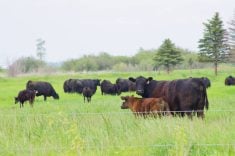A Canadian company plans to soon release a monitoring device that can be used by both large and small producers
A Calgary company aims to bring remote monitoring to cattle for early detection of illness.
HerdWhistle is releasing new products in 2024, aiming to reduce labour for producers and increase the capacity to identify illness.
Jack Behan, CEO of HerdWhistle, says the new product known as the BigEye can tell if an animal is sick up to six days in advance of obvious symptoms.
“The idea of pen riders in feedlots … often the poor guys have got 15,000 animals, or whatever it is, 300 a pen,” Behan says.
Read Also

House ag committee to undertake several studies
The House of Commons standing agriculture committee has set its agenda for the coming months. Members began the fall sitting with a two-hour update on international trade
“They probably see animals far too late to make a difference if those animals are sick. So, what we have now is a system that identifies an animal as sick, and then it also tells the pen rider which pen it’s in.”
The BigEye is a multispectral camera with infrared thermographic imaging and built-in UHF tag readers.
Behan says the camera focuses on animals’ eyes because they are the most sensitive area to temperature.
“When you have a cold, what generally happens is your eyes water, you get a stuffy nose,” he says. “That’s because the heat is being generated in your head. Exactly the same with cattle, pigs, sheep, goats, whatever. Then (the BigEye) says this animal is outside the normal range, it’s at risk.”
Braden Bjornson, chief experience officer at HerdWhistle, says the company is in the production stage and the BigEye will be released early this year. Some have already been ordered.
The cost is $1,500, with a $700 per month subscription fee.
“What that means is they’ve got access to their own data coming back to them in real time. And as we add further applications, then they’ll pay more depending on what they want to see,” says Behan.
The amount producers will save by treating only animals identified as sick will justify the cost, he added.
“Instead of spending $40 or whatever it is on an antibody cocktail, you spend on average $4 because you’ve only got one in 10 that is sick. And you start to do things that are adding up.”
Soon after BigEye will come LittleEye, an option for smaller producers.
Bjornson says the LittleEye will be a handheld unit the producer can hold up to the eye of an animal. He says it should also work for cats and dogs.
Behan says the LittleEye will work on eight different species, including people. He says it can be used to give people peace of mind when it comes to the health of their pets.
“Often where we live in rural communities, we want to know whether or not we should go into town and take the dog because there’s something wrong… But the idea of being able to give a bio-surveillance check on your animals before you spend that money can be very comforting.”
The LittleEye is set to go into production sometime in 2024.


















